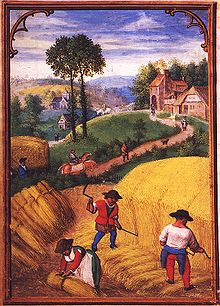Sift
The faces , also called House gene density, Siget or knee Sense, together with the associated Mahdhaken a hand tool for mowing of cereal .
history
Together with the mowing hook necessary for working with it, views are already shown on late medieval miniatures. It is open, however, whether there was a transitional form between the sickle and the sight. There are images of unclear fidelity to the image, both of sickles with an upright, short stem and of regular sightings, which, however, do not have the scythe-like, only slightly curved leaf of the modern designs of sighting, but a crescent-shaped leaf similar to that of a sickle. Due to the mechanization of the grain harvest, especially since the introduction of the combine harvester and the combine harvesters that appeared later, the view has become meaningless in agricultural practice.
Execution and working technique
The relatively short leaf of the sight is similar to that of a scythe , but has a different angle between leaf and hammer . The handle of the sight is only arm-length with only a short handle at the top. The sharpening of the sight sheet is done like with the scythe by hammering and whetting .
The viewer is held by the handle with the right hand, while mowing is done in a slightly stooped position with a swinging movement into the crop. With the mowing hook belonging to the sighting , a forged hook on an iron or wooden handle, the grain stalks to be mowed are separated and pressed against the grain that is still standing for the time being. The mowing hook is also used after the individual cutting process to gather the mown grain and pull it aside. In the mowing hook handle there is partially a recess in which the sight can be inserted, either to put it down in the field or to shoulder it for transport. There are greater differences in the design of the mowing hook than in the case of the sight itself. There are essentially three different basic designs: the straight hook protruding at right angles to the handle and the convex or concave curved hook.
Compared to other hand tools for grain harvesting
The advantage of mowing grain with the sight over the scythe is that the stalks and ears of wheat come to lie next to each other more evenly and without confusion, making threshing easier; Compared to the sickle , which is still more advantageous , the straw yield is higher due to the lower stubble height. With the sight one achieves a lower area coverage than with mowing the grain with the scythe. On the other hand, the work process is more effortless. In contrast to the process with scythe and sickle, the pure cutting movement occurs through the own swing of the tool, which the worker only has to actively move back.
literature
- August Gottfried Schweitzer: Concise textbook of agriculture for use in lectures about the same . Arnoldsche Buchhandlung, Leipzig 1834, p. 75
- William Löbl: Handbook of agriculture . Arnoldsche Buchhandlung, Dresden - Leipzig 1849, p. 195 f.
- Adam Müller: Textbook of Agriculture . Kunze, Mainz 1862, p. 177
- Meyers Großes Konversationslexikon, 6th edition 1905–1909, article: Sichte
- Heinz-Peter Mielke: Niederrheinisches Freilichtmuseum Grefrath (museum guide) . Self-published by the Museum Association Dorenburg e. V., Grefrath 1997, ISBN 3-932793-00-5
Individual evidence
- ↑ a b Charles de Mooij, Renate van de Weijer (ed.): Rijke oogst van schrale Grond. An overzicht van de Zuitnederlandse material folk culture approx. 1760-1900 . Wanders Uitgevers, Zwolle 1991, ISBN 90-6630-277-1 , p. 44
Web links
- Video: Dengeling and sharpening the sight
- Video: mowing with sight
- Website of the Austrian scythe club


